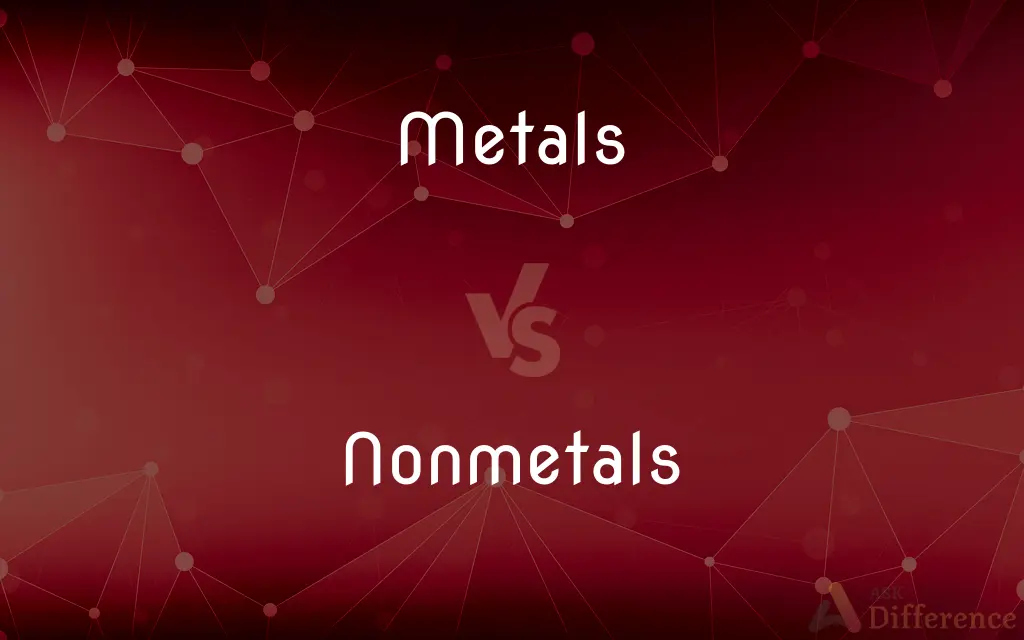Metals vs. Nonmetals — What's the Difference?
Metals are typically shiny, ductile conductors of heat and electricity, used for structural and electrical applications. Nonmetals, characterized by their lack of luster and poor conductivity, play crucial roles in biological processes and as insulators.

Difference Between Metals and Nonmetals
Table of Contents
ADVERTISEMENT
Key Differences
Metals, found on the left side of the periodic table, are elements known for their high electrical and thermal conductivity, malleability, ductility, and often a shiny appearance. Nonmetals, located on the right side of the periodic table (except hydrogen, which is positioned on the left), exhibit much lower conductivity, are not malleable or ductile, and do not possess the metallic luster. Nonmetals are essential in various fields, including the creation of biological compounds (like DNA, which contains phosphorus), and as key components in technologies that require insulating materials.
Metals generally have high melting and boiling points, making them suitable for applications requiring durability and resistance to high temperatures, such as engines and cookware. Nonmetals, on the other hand, vary greatly in their boiling and melting points; for instance, oxygen is a gas at room temperature, while silicon, a metalloid with some nonmetallic properties, has a high melting point and is used in computer chips.
The reactivity of metals and nonmetals also differs significantly. Metals tend to lose electrons in chemical reactions, forming positive ions (cations). This property is exploited in batteries, where metal reactions are fundamental to generating electrical energy. Nonmetals typically gain electrons to form negative ions (anions) or share electrons to form covalent bonds, which is critical in organic chemistry and the formation of life-sustaining molecules, like water.
Density is another differing factor; metals usually have higher densities and are heavier for their size, which is why they are used in applications requiring strength and durability, such as vehicles and machinery. Nonmetals, with lower densities, find uses in applications where weight is a concern, for example, hydrogen is used in lighter-than-air balloons.
Environmental interactions also showcase their differences; metals can corrode, losing electrons and deteriorating over time when exposed to certain environments, necessitating the use of alloys or protective coatings in many applications. Nonmetals, such as nitrogen and carbon, play critical roles in the environment, participating in life cycles and the greenhouse effect, highlighting their importance beyond industrial uses.
ADVERTISEMENT
Comparison Chart
Appearance
Shiny luster
Dull, lack of luster
Conductivity
High electrical and thermal conductivity
Poor conductivity
Malleability and Ductility
Yes, can be shaped and stretched
No, brittle in solid form
Melting and Boiling Points
Generally high
Varied, can be low or high
Reactivity
Lose electrons to form cations
Gain or share electrons
Density
High
Lower compared to metals
Common Uses
Construction, electrical wiring, machinery
Insulators, biological processes
Environmental Interactions
Can corrode
Participate in biological cycles
Compare with Definitions
Metals
Malleable and ductile, allowing shaping and stretching.
Aluminum can be rolled into thin foils for packaging.
Nonmetals
Poor conductors of heat and electricity.
Rubber is used as an electrical insulator.
Metals
High melting and boiling points.
Iron is used in construction for its strength and high melting point.
Nonmetals
Not malleable or ductile; solid nonmetals are brittle.
Sulfur breaks into powdery pieces when struck.
Metals
Typically have a shiny luster.
Silver is used in jewelry for its bright metallic shine.
Nonmetals
Tend to gain or share electrons in chemical reactions.
Oxygen forms water by sharing electrons with hydrogen.
Metals
Tend to lose electrons in reactions, forming cations.
Sodium reacts with water, releasing hydrogen gas and forming sodium ions.
Nonmetals
Lack a metallic luster and are often dull.
Carbon, in the form of graphite, is used as a lubricant and for pencil leads.
Metals
Plural of metal
Nonmetals
Any of a number of elements, such as oxygen or sulfur, that lack the physical and chemical properties of metals.
Metals
An alloy of two or more metallic elements.
Nonmetals
Varied melting and boiling points.
Bromine is liquid at room temperature.
Metals
Good conductors of electricity and heat.
Copper is widely used in electrical wiring due to its excellent conductivity.
Nonmetals
Plural of nonmetal
Common Curiosities
Are all metals solid at room temperature?
Most are, except mercury, which is liquid at room temperature.
How do nonmetals react in chemical reactions?
Nonmetals tend to gain or share electrons, forming anions or covalent bonds.
Why are metals used in wiring and cables?
Metals’ high conductivity makes them ideal for efficiently transmitting electricity.
Can nonmetals conduct electricity?
Generally, no; nonmetals are poor conductors, with graphite being a notable exception due to its unique structure.
Why are nonmetals important in technology?
Nonmetals are essential in semiconductors, batteries, and insulators, critical for electronics and energy storage.
What distinguishes metals from nonmetals?
Metals are conductive, shiny, and malleable, while nonmetals are insulative, dull, and brittle.
What role do nonmetals play in the environment?
Nonmetals are crucial in biological cycles, such as carbon in the carbon cycle and oxygen in respiration.
How do metals and nonmetals differ in chemical bonds?
Metals form ionic bonds by transferring electrons, while nonmetals form covalent bonds by sharing electrons.
How are metals extracted from ores?
Through processes like smelting, where ores are heated to release the metal.
Why are metals more dense than nonmetals?
Metals have closely packed atoms, resulting in higher densities.
Can metals be found in their pure form in nature?
Some metals, like gold and silver, can be found in their pure state, but most are found as ores and require extraction.
What is the most reactive metal?
Francium is considered one of the most reactive, though its reactivity is mostly theoretical due to its rarity.
What is a metalloid?
Metalloids have properties intermediate between metals and nonmetals, such as silicon, used in semiconductors.
Can the properties of metals and nonmetals overlap?
Yes, in metalloids and under certain conditions, elements can exhibit properties of both classes.
What is the most abundant nonmetal on Earth?
Oxygen is the most abundant nonmetal in the Earth's crust and atmosphere.
Share Your Discovery

Previous Comparison
Nautical Mile vs. Statute Mile
Next Comparison
Asian Lady Beetle vs. Ladybug













































